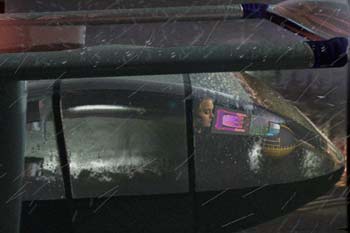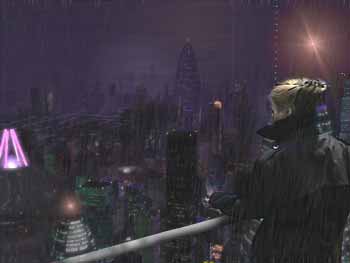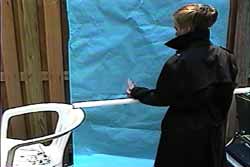 |
|
||
| .
. . Characters Backstory |
The Special Effects of "Copyright for Hire"
All of the shots you see here were created for almost no money, using common and cheap materials which almost anyone has access to. Although the movie is being digitally mastered, it was shot using a mix of VHS, SVHS, 8mm, Hi8, and DVCam footage. Actors made themselves available for 3-4 hour shoots on weekends and nights. Practical props and effects were created from toy parts and hot glue by a small team of talented artists. All 3D models and renders were created using the venerable Infini-D 4.5 for Macintosh. Most of the final render frames were rendered on an old Macintosh 6400 (200mhts 603e w/ 98Meg of RAM). More recently my brother's iMac 266 and borrowed cycles from G4 systems at work have rounded out the rendering process. Infini-D was chosen because I went to college with some the software’s original engineers, and it is very cheap for the quality and flexibily it affords the intermediate animation enthusiast like myself. The big budget item is the use of Adobe's After Effects 4.1. More recently some segments have been rendered at work using my companies Dual Processor G4 and After Effect 5.5 Production Bundle. The methods employed here could apply to almost any mix of hardware and software. Currently I am tweaking the rain particle routines for the opening sequence. Previous composite plates for these scenes employed a very basic 2D rain filter in AE. Now rain is being volumetrically rendered as a particle system, complete with splashing drops which spawn smaller particle droplets when they hit a surface. Portions of scenes which are part of the 2D video footage are recreated with simple forms in 3D to allow rain drops to interact with previously shot live footage.
In this portion of the opening sequence a flying car transports Ms. Poe to visit with the copyright cops. The background plate is night footage shot with a consumer 8mm camcorder out of a car window. The flying car is a GC model rendered in Infini-D. Water movement on the windshield is a bump-map applied to the car model. This bump map was created in AE using a variety of hand airbrushed textures and warping filters. Illuminated car controls were designed in Freehand and assembled in Photoshop Then the control designs were applied to simple geometry in Infini-D and rendered with the same movements as the car model to simplify compositing. Particle based rain was rendered in several passes, with different levels of bounce and splatter, to interact with the car model. The frame shown here has 23 layers composited in AE. The actress portraying Ms. Poe was hand rotoscoped out of another scene to appear inside the car.
This is the first shot in the film, and it establishes a sense of place for this dark science fiction satire. Ms. Poe looks from a balcony over the downtown skyline of the city of New Tarsis. More than two-hundred basic building structures were assembled in Infinfi-D to create the cityscape fore and middle ground. Buildings were placed in the scene from a stock set of six basic building types. Each building type had a photograph of windows from real buildings in Houston and Los Angeles mapped onto it. Rooftops had hand painted parked cars and other details which were drawn in Photoshop. A bump map was applied to all photographic and painted detail to finish the effect of scale and complexity. The 3D buildings were extended by a matte painting which added more buildings throughout the fog and rain.
In 1996 early production footage of Agent Pi was shot with room in the frame for additional matted elements. While most of these shots were recorded with a locked-down camera, it was decided that some of the wild takes had better performance aspects from the talent. This meant that additions to the plates had to be hand rotoed. The city skyline mattes in these scenes were the same ones used to extend the opening shot of the city.
|




